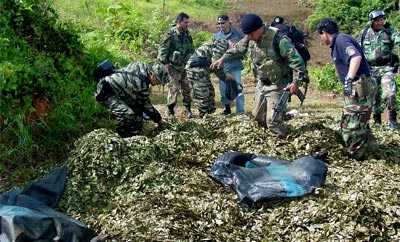The head of Colombia’s Anti-Narcotics Police claims drug traffickers are importing coca base from Peru and Bolivia to be shipped out of Colombia, pointing to a possible move back to the drug trafficking dynamics of the original cocaine boom years.
“We are seeing the same phenomenon as 30 years ago, when coca base arrived from [Peru and Bolivia] and they produced [cocaine] hydrochloride here,” said General Ricardo Restrepo in an interview with El Tiempo.
According to the official, significant amounts of the cocaine hydrochloride leaving the country is not produced in Colombia, with the country used as a transit point for drugs sourced elsewhere.
Restrepo also underlined how trafficking organizations often group shipments together, paying a “tax” to larger criminal organizations to oversee and guarantee the delivery of consignments. He highlighted the example of a recent record-breaking seven ton seizure discovered in Cartagena that was partly owned by a Mexican cartel.
InSight Crime Analysis
On some level, a return to the 1980s drug trafficking dynamic commonly associated with former kingpins such as Pablo Escobar — whereby cheap Peruvian and Bolivian coca paste was transported to be processed in Colombia — makes sense.
Cocaine production in Colombia has fallen drastically over the past decade, with coca leaf cultivation dropping from 163,000 hectares in 2000 to 48,000 in 2012, and the country has the toughest eradication policies in the region. In 2013, the United Nations Office on Drugs and Crime (UNODC) confirmed that Peru had re-established itself as the world’s primary coca cultivator and cocaine producer.
However, Peru only produces an estimated 12,000 hectares of coca more than Colombia, and Colombian drug traffickers should not be short of product despite the declining supply. Peruvian coca paste may well be cheaper than that produced in Colombia, but its value increases at every stage of a trafficking route, reducing savings traffickers make.
SEE ALSO: Coverage of Criminal Migration
Government attempts to control the legal coca market while tackling the cocaine trade in Bolivia meanwhile, has seen the country become an increasingly expensive source of coca base, and it has even been reported that Bolivia is used not as a source country for Colombian groups, but as a transit country for Colombian product.
The General’s comments also appear strange in light of reports that Colombian traffickers are reportedly shifting processing operations to Central America and elsewhere in the face of increasingly effective policing in their homeland. In recent years, cocaine labs have been discovered in traditional drug transit countries such as Honduras, Guatemala and Panama.

